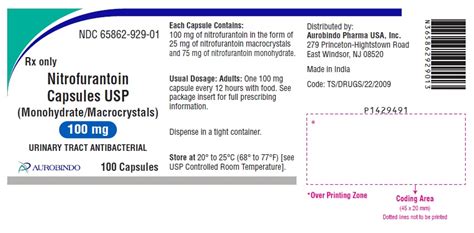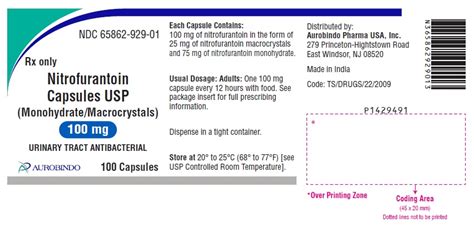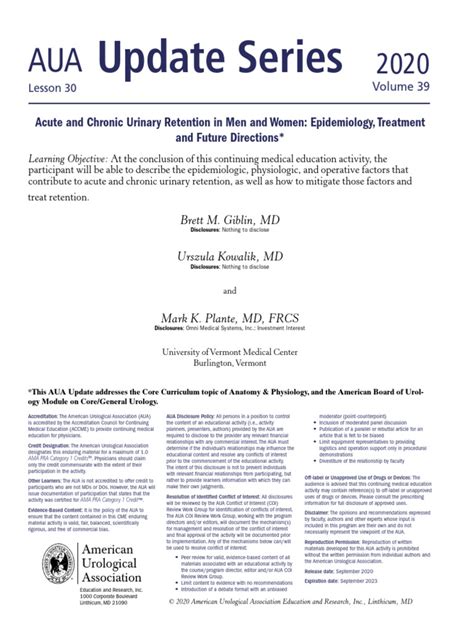Intro
Discover key facts about Nitrofurantoin Mono, a common antibiotic for UTI treatment, including its uses, side effects, and interactions, to better understand this medication and its role in urinary tract infection management.
Nitrofurantoin mono, a commonly prescribed antibiotic, has been a staple in the treatment of urinary tract infections (UTIs) for decades. Its effectiveness and relatively low risk of side effects have made it a favorite among healthcare professionals. However, as with any medication, there are certain facts that patients should be aware of to ensure safe and effective treatment. In this article, we will delve into five key facts about nitrofurantoin mono, exploring its benefits, potential drawbacks, and what patients can expect during treatment.
The importance of understanding nitrofurantoin mono cannot be overstated. As antibiotic resistance continues to rise globally, it's crucial that patients are informed about the medications they're taking. This knowledge not only helps in managing expectations but also in adhering to treatment regimens, which is vital for the medication's success. Moreover, being aware of the potential side effects and interactions can significantly improve patient outcomes by allowing for prompt intervention should any issues arise.
Nitrofurantoin mono is specifically designed to target bacteria that cause UTIs, making it a highly effective treatment option for this common condition. Its mechanism of action involves damaging the bacterial DNA, thereby inhibiting the bacteria's ability to reproduce and eventually leading to their death. This targeted approach reduces the risk of disrupting the body's natural flora, which is a common issue with broad-spectrum antibiotics. However, despite its efficacy, there are several factors that patients should consider when taking nitrofurantoin mono, including its potential side effects, interactions with other medications, and the importance of completing the full treatment course.
Nitrofurantoin Mono Mechanism of Action

Benefits of Nitrofurantoin Mono
The benefits of nitrofurantoin mono are numerous, making it a preferred choice for many healthcare providers. One of the significant advantages is its targeted approach, which minimizes the risk of antibiotic resistance. Additionally, nitrofurantoin mono has a relatively low risk of side effects compared to other antibiotics, although patients should be aware of potential issues such as nausea, vomiting, and diarrhea. The medication is also effective against a range of bacteria that cause UTIs, including E. coli, which is responsible for the majority of UTI cases.Potential Side Effects of Nitrofurantoin Mono

Interactions with Other Medications
Nitrofurantoin mono can interact with other medications, which may affect its efficacy or increase the risk of side effects. Patients should inform their healthcare provider about all medications they are taking, including supplements and over-the-counter drugs. Certain medications, such as probenecid and sulfinpyrazone, can decrease the excretion of nitrofurantoin, potentially leading to higher drug concentrations in the body. Understanding these interactions is crucial for minimizing risks and ensuring the safe use of nitrofurantoin mono.Importance of Completing the Full Treatment Course

Practical Tips for Patients
For patients taking nitrofurantoin mono, there are several practical tips that can enhance the treatment experience. Staying hydrated by drinking plenty of water can help in flushing out the bacteria and reducing the concentration of the medication in the urine, which may help minimize potential side effects. Additionally, taking the medication with food can reduce gastrointestinal side effects. Patients should also be aware of the signs of a more severe UTI or an allergic reaction to the medication, such as difficulty breathing, and seek immediate medical attention if these symptoms occur.Nitrofurantoin Mono and Pregnancy

Statistical Data on Nitrofurantoin Mono Efficacy
Statistical data on the efficacy of nitrofurantoin mono in treating UTIs are compelling. Studies have shown that the medication achieves high cure rates, often exceeding 80%, depending on the bacterial strain and patient compliance. These statistics underscore the value of nitrofurantoin mono as a first-line treatment for uncomplicated UTIs, offering patients a reliable option for managing their symptoms and overcoming the infection.Future Directions in UTI Treatment

Conclusion and Next Steps
In conclusion, nitrofurantoin mono remains a valuable treatment option for UTIs, offering patients an effective and relatively safe way to manage their symptoms and overcome the infection. By understanding the mechanism of action, benefits, potential side effects, and importance of completing the full treatment course, patients can make informed decisions about their care. As research continues to uncover new insights into UTI treatment, it's essential for patients to stay informed and work closely with their healthcare providers to ensure the best possible outcomes.What is nitrofurantoin mono used for?
+Nitrofurantoin mono is used to treat urinary tract infections (UTIs) caused by certain bacteria.
How long does it take for nitrofurantoin mono to work?
+symptoms of UTI may start to improve within a few days of starting nitrofurantoin mono, but it's essential to complete the full treatment course as directed by your healthcare provider.
Can I take nitrofurantoin mono during pregnancy?
+Nitrofurantoin mono can be used during pregnancy but with caution, especially in the third trimester. It's crucial to discuss the risks and benefits with your healthcare provider.
We hope this comprehensive overview of nitrofurantoin mono has provided you with valuable insights into its use, benefits, and potential side effects. If you have any further questions or would like to share your experiences with nitrofurantoin mono, please don't hesitate to comment below. Your feedback and stories can help others make informed decisions about their health. Additionally, consider sharing this article with friends and family who may benefit from this information, helping to spread awareness about the safe and effective use of antibiotics.
